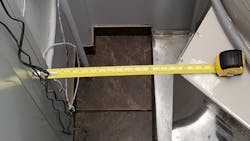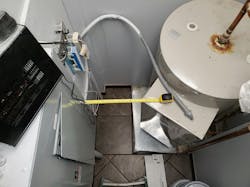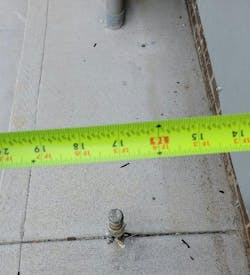Dedicated Electrical Spaces About Electrical Equipment
Electrical equipment’s dedicated space requirements are an example of an X/Code, defined as a crossover code or when one code affects another. That is the case in this situation because plumbers (and other trades) often place their equipment inside the electrical equipment’s dedicated space, which might not be a code violation for them, but it is a violation of the National Electrical Code (NEC).
The commercial water heater in Photo 1 is only 15 in. from the front of the electrical panel. The NEC requires at least 36 in. of “clear” working space. In addition, the plumbing code (IPC Sec. 502) states: “Electrical water heaters shall conform to the requirements of this code and provisions of NFPA 70 (the National Electric Code).” This is the cross/code element.
This installation is a triple fail. First, the plumber should have complied with the requirements in the NEC. Second, the electrician should have been involved in energizing the water heater, and they should have seen the Code violation. Third, this installation should have required a permit and inspections. The inspector should have been all over this non-code-compliant installation.
NEC rules specific to this installation
110.26(E) Dedicated Equipment Space. All switchboards, switchgear, panelboards, and motor control centers shall be located in dedicated spaces and protected from damage.
110.26 Spaces About Electrical Equipment. Access and working space shall be provided and maintained about all electrical equipment to permit ready and safe operation and maintenance of such equipment.
(A)(1) Depth of working space. This space shall not be less than 36 in. directly in front of the panel and equal to the width.
(A)(2) Width of the working space. This space shall not be less than the width of the electrical equipment or 30 in. (whichever is greater). In all cases, the workspace shall permit at least a 90° opening of equipment doors or hinged panels.
(E)(1) Indoor dedicated electrical space. The space equal to the width and depth of the equipment and extending from the floor to a height of 1.8 m (6 ft) above the equipment or to the structural ceiling, whichever is lower.
Photo 2 demonstrates another violation of the dedicated space rule. A natural gas line for a gasoline station is only 17 inches from the electric trough. At rough-in, it was not obvious that the gas line was going to be in the dedicated electrical space.
This NEC violation was discovered during the temporary to permanent inspection. It is a violation of Sec. 110.26E(2)(b), which has the same 36- and 30-inch requirements as Sec. 110.26(A). In this situation, the builder had to (reluctantly) relocate the natural gas line. He was not happy about it because “technically” the trough and panels were placed after the gas line was placed — and after the sidewalk was poured.
As an electrical inspector, this does not matter. The installation as completed violated the NEC. We don’t care who was there first. The final product is what matters. In this case, the power cannot be turned on until the gas line is moved out of the dedicated electrical space. This failure was due to the construction superintendent not watching what his subcontractors were doing. His lack of planning and supervision does not relieve him of complying with the code requirements.
About the Author
Joseph Alexander
Joseph Alexander, C.B.O., C.F.M, M.C.P., is the chief building official for the City of Suwanee, Ga. He can be reached at [email protected].


